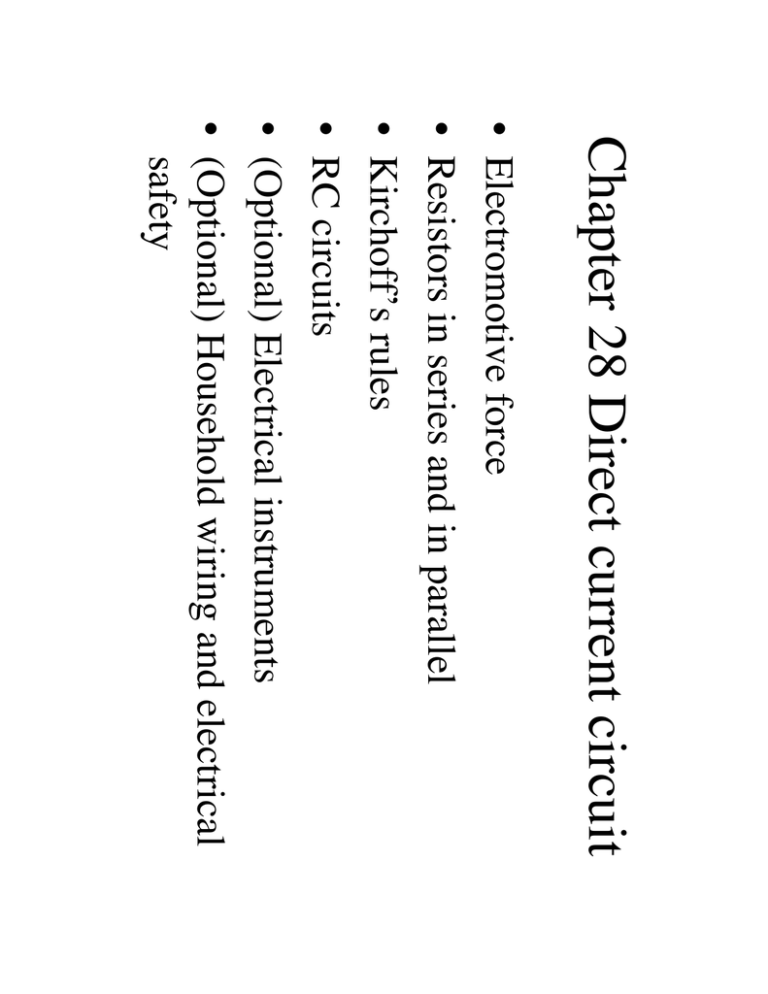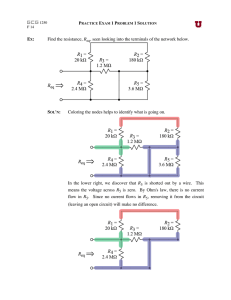Document
advertisement

• • • • • • Chapter 28 Direct current circuit Electromotive force Resistors in series and in parallel Kirchoff’s rules RC circuits (Optional) Electrical instruments (Optional) Household wiring and electrical safety p = eI = I 2 r + I 2 R e - Ir = IR, e = I( r + R) Electromotive force Vb -Va = e - Ir Vb -Va = Vc -Vd = IR Matching the load e2R p= (r + R)2 e p = I 2 R, I = r+R Show that the maximum power delivered to the load resistance occurs when the load resistance matches the internal resistance, that is, when R = r. † dp (r + R)2 - 2R(r † + R) = e 2[ ]= 0 dR (r + R)4 R=r Resistors in series Req = R1 + R2 + ... DV = IR1 + IR2 = I (R1 + R2 ) Req = R1 + R2 For a series combination of resistance, the currents in all the resistors are the same. † Resistors in parallel 1 1 1 1 Req = + , Req = + + ... R1 R2 R1 R2 DV DV 1 1 DV I = I1 + I 2 = + = DV ( + ) = R1 R2 R1 R2 Req When resistors are connected in parallel, the potential differences across them are the same. † Rpara RR = 1 2 R1 + R2 Find the equivalent resistance † Find the equivalent resistance by symmetry Kirchhoff’s rules 1. The sum of the currents entering any junction in a circuit must equal the sum of the currents leaving that junction: Â I in = Â I out 2. The sum of the potential differences across all † elements around any closed loop must be zero: Â DV = 0 closed loop Sign conventions Each circuit element is traversed from left to right 22V = (11W)I1 I1 = 2A, I 2 = -3A, I 3 = -1A 10V - (6W)I1 - (2W)(I1 + I 2 ) = 0 (4) 10V = (8W)I1 + (2W)I 2 (5) -12V = -(3W)I1 + (2W)I 2 (2) abcda 10V - (6W)I1 - (2W)I 3 = 0 (3) befcb - (4W)I 2 -14V + (6W)I1 -10V = 0 (1) I1 + I 2 = I 3 Example 28.8 Applying Kirchhoff’s rules † † DVcap = 11.0V, Q = CDVcap = 66.0mC -8.00V + DVcap - 3.00V = 0 (1) I1 + I 2 = I 3 (2) defcd 4.00V - (3.00W)I 2 - (5.00W)I 3 = 0 (3) cfgbc (3.00W)I 2 - (5.00W)I1 + 8.0V = 0 I1 = 1.38A, I 2 = -0.364 A, I 3 = 1.02A Example 28.9 A multiloop circuit † † q e - - IR = 0 C e t = 0, q = 0 so I = 0 R t = •, I = 0 so Qmax = Ce Charging a capacitor † 1 t RC ) 1 -1t e -1t I = dq / dt = Ce ( )e RC = e RC RC R q = Ce (1- e q dq dq q - Ce e - - R = 0, =C dt dt RC q dq 1 dq 1 =dt, Ú =t q - Ce RC RC 0 q - Ce q - Ce 1 ln( )=t -Ce RC Charging a capacitor When t = t = RC I = e-1 I 0 † - 1 t RC Q -1t I = dq / dt = e RC RC q = Qe q dq dq q - - R = 0, =C dt dt RC q dq 1 dq 1 =dt, Ú =t q RC RC Q q q 1 ln( ) = t Q RC Discharging a capacitor † Discharging a capacitor in an RC circuit - 1 t RC 1 t 1 t RC - 2 U0 / 4 = U0e t - 1 t RC 1 t q2 U= , q = Qe RC 2C 2 2 t Q2 - t U= e RC = U 0 e RC 2C Consider an RC circuit. (a) After how many time constants is the charge on a capacitor one-fourth its initial value? (b) After how many time constants is this stored energy one-fourth its initial value? q = Qe Q / 4 = Qe - -1 / 4 = e RC -ln 4 = -t / RC t = RC(ln 4) = 1.39RC = 1.39t -1 / 4 = e RC -ln 4 = -2t / RC t = RC(ln 4) / 2 = 0.693RC = 0.693t





